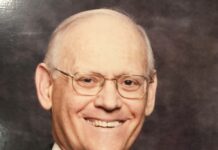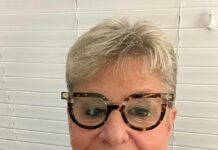
Richard Bank’s pocket watch, given to him by his grandfather and Shoah survivor Ludwig Frank, hasn’t kept time for decades, save for two occasions.
The first was shortly after Bank’s 30th birthday, when his wife Francine gifted him a stand for the watch: a spindly silver tree with no leaves, but a tear beginning to drip from the top branch. “Ludwig Frank” is engraved on the stand, winding around the tree’s roots and trunk, and the stand was dubbed the ‘Tree of Sorrow.’
While sitting in his study, Bank, 74, touched the watch resting on the tree, and the second hand immediately began spinning, the watch ticking rhythmically.
Though the watch went silent the next morning, two weeks later, the same thing happened. Upon showing his mother Ruth Frank the watch stand, Bank once again noticed the watch ticking again, and then stopping, remaining still for the next
44 years.
“The message of the watch is survival,” Bank said.
Like his grandfather before him, Bank gave his grandson Hayden the watch and the Tree of Sorrow for his bar mitzvah on Oct. 24. Along with the watch, Bank also gave Hayden the responsibility of carrying on the memory of the Holocaust, the same responsibility Ludwig Frank passed down to his grandson through the watch.
Bank describes himself as “growing up in the shadow of the Holocaust,” a phrase that doubles as the subtitle of his newest book ‘Tree of Sorrow,’ published by Auctus Publishers in
July 2021.
Though a lawyer for most of his life, Bank has been writing since the age of 12. He lived in Strawberry Mansion and went to grade school in Mt. Airy before attending Temple University and later University of Pennsylvania, where he studied law. Throughout school, Bank had a passion for writing.
The story of his grandfather’s watch was first published in The Jewish Exponent in 1978 and is again recounted in ‘Tree
of Sorrow.’
The memoir, which mostly unfolds Bank’s childhood and time in undergraduate and law school, is the third book in what Bank calls an “inadvertent trilogy.”
He published “Feig” and “I Am Terezin” in 2014 and 2017, respectively, and while the former is fiction and the latter, non-fiction, ‘Tree of Sorrow’ is a work of creative nonfiction, and a personal one at that.
Despite growing up with an “oma” and “opa” who survived Theresienstadt and a mother who was a refugee of the Holocaust, Bank knew surprisingly little about his family’s experience of the Shoah.

Though Bank could speak some German to communicate with his grandparents, they skirted the topic of the Holocaust.
“They never spoke about it. My mother never spoke about it. Her sister never spoke about it. The family never spoke about it,” Bank said.
Despite his grandmother living until he was 21, Bank never asked her about her time in Theresienstadt.
He published “I Am Terezin” about the camp without knowing that he also had an aunt on his mother’s side who died in Theresienstadt. Four other great aunts and uncles — his grandfather’s siblings — also died in the Shoah. He had no idea until he spoke with his mother shortly before the book’s publication.
“I grew up with the idea that you don’t ask,” Bank said. “That’s why I’m writing so much about it now — because I do want to know about it, and I want to share with others, so that other people know about it and don’t take that same attitude.”
Bank is still committed to learning more about his family history, largely thanks to his grandson.
Hayden, 13, inspired by an older cousin’s family tree on a different side of his family, took on the responsibility of creating a Frank family tree in September 2020 as a project during COVID.

“I wanted it done; I didn’t want anyone else doing it,” Hayden said. “And I felt like this was my opportunity to do it.”
With the help of Bank’s cousins, Hayden uploaded his family tree to Ancestry.com. Hayden and Bank then received an email from Roland Paul, a historian who had been in contact with Bank’s mother, whom he met during her trips back to her hometown of Odenbach, Germany after the Holocaust. From there, the family tree grew even larger.
The family tree now spans eight generations, with over 120 entrees. Hayden hopes to share the updated family tree with Bank’s cousins and extended family at a family reunion next spring.
Hayden’s great grandmother and Bank’s mother died when Hayden was 9 years old, but Hayden remembers visiting his great grandmother’s apartment and finding a photograph of the Frank family from 1914. Before his family tree research, Hayden could only identify a few of the relatives in the photo. Now he can identify almost all of them.
At the pending family reunion, Hayden will meet some of Bank’s cousins for the first time. Bank will be meeting some of them for the first time too.

Hayden calls his grandfather every day and has read ‘Tree of Sorrow’ and the books that preceded it. As time goes on, Hayden thinks he gets more and more similar to his grandfather.
“We’ve always been like the same person,” Hayden said. “But when I got to read his book, that’s when I realized we basically have the same exact characteristics as each other.”
Bank insists that when he gave Hayden Ludwig Frank’s watch and the Tree of Sorrow, he had no agenda for what he believed Hayden should do with it.
And Hayden has a fierce loyalty to Bank: “I always tell him to this day, ‘I’m going to make sure I take care of you one day.’”
Because of Hayden’s commitment to his family, Bank has no concerns about the fate of his grandfather’s watch.
“He’s already fulfilled his responsibility to the watch,” Bank said. “Maybe one day he’ll want to pass it on, and then he’ll pass on the story of the watch and the memory of the Holocaust.”
[email protected]; 215-832-0741






